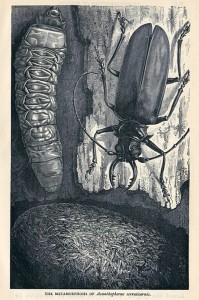
A team of entomologists in India had to put their new species celebration on hold last year, when they found out their discovery had already been discovered.
The Journal of Insect Science paper, initially published in December 2012, was retracted in October 2013, after several entomologists confirmed that the beetle was actually a previously identified species called Acanthophorus serraticornis. (The notice has a November 2014 date, but we understand that’s because the journal switched servers.)
Here’s the notice for “A new record of longicorn beetle, Acanthophorus rugiceps, from India as a root borer on physic nut, Jatropha curcas, with a description of life stages, biology, and seasonal dynamics”:
This paper (originally published as 12.141) described the root borer, Acanthophorus rugiceps Gahan (Coleoptera: Cerambycidae), as a new record on physic nut, Jatropha curcas L. (Malpighiales: Euphorbiaceae), in India. The species involved has since been identified as Acanthophorus serraticornis (Olivier) by Dr. Alain Drumont (Entomology Department, Institut Royal des Sciences naturelles de Belgique, Bruxelles Belgium), which is known to be present in India. The original paper has therefore been withdrawn.
Richard Levine of the Entomological Society of America, which publishes the Journal of Insect Science, gave us a play-by-play on how the error was discovered:
As it says in the retraction document, Alain Drumont from the Entomology Department at the Institut Royal des Sciences naturelles de Belgique was indeed the one who first pointed out the misidentification to Dr. Henry Hagedorn, the editor-in-chief of JIS who passed away in January 2014.
Dr. Mathyam Prabhakar, one of the authors of the paper, also received notice that the insect was misidentified. After consulting with some local taxonomists, who agreed that it had been misidentified, he wrote to Dr. Hagedorn about it. Dr. Hagedorn then decided to withdraw the paper.
The paper has been cited three times, according to Thomson Scientific’s Web of Knowledge.
Cataloguing species in the field is tricky. We’ve seen similar mix-ups before, from plants to snakes. It’s just another reminder that, if we are in the sixth mass extinction, we might not know what we’ve got ’til it’s gone – or even after.
Hat tip: JATdS
Sorry to just learn Dr Hagedorn passed away. He was a man of his senses.
Just based on blunt reasons I usually would oppose to retracting a paper based on a misID as entomological taxonomy can get quite tricky — a correction should do. However upon reading the paper I see it was originally quite limited in technical content, and heavily relied on discussing the fact that this “new beetle” was also a potential threat, etc, and this completely lost its point when the actual ID of the beetle was confirmed as a well-known widespread pest.
You know that “entomological taxonomy can get quite tricky” (I know little, but have been told repeatedly that differences in insect species can be extremely subtle.) But isn’t that a reason to carefully compare your “new bug” with other similar, known bugs, especially when the “old bug” is so widespread? What did it say in the paper was the difference(s) between the new bug and the old bugs?
It seems just identifying a “new bug” wasn’t enuf– they had a discussion of the potential threat it posed, plus talked about life stages and so on. That sounds like they might have felt it needed padding… you seem to be saying that the paper deserves retraction for that reason, and I would agree.
As far as mass extinctions go, a subject which troubles me greatly: this is the type of species that has a better chance of surviving (like cockroaches); we are the type of species that is more likely to go under: an apex predator, large and slow to reproduce, that needs a lot of resources to get by.
This happens occasionally in microbiology. After sequencing 16S it may become apparent that a organism may be identical to a known species. However, it may take metabolic assays or a fully sequenced genome to ascertain whether the organism is identical.
The original paper by Prabhakar et al. was not describing a new species, but rather reporting natural history observations for a previously described species that they thought they were recording for the first time in India, and on a host plant that it had not previously been recorded on. There is significant difference between reporting new geographic and host records and describing a brand new species.
The fact that this paper was retracted greatly concerns me. By all admissions, the science and natural history published in the paper were considered accurate and not malicious, and that it was only the name of the beetle that was incorrect (an error that was also unlikely to be unintentional or malicious). Species are misidentified quite frequently in the peer-reviewed literature, especially in groups where identification resources are difficult to find, use or are totally nonexistent. However, rather than writing to the editor and retracting the paper, most instances of misidentification will have a correction published alongside them, or another scientist will publish their own paper establishing why they believe the species was misidentified, and attributing any previously published data to the correct species.
While it’s unlikely the original paper would have been published in this journal if they had identified it correctly the first time, largely because it’s a confirmatory result rather than a novel observation, the information was, and still is, valuable, especially in the proper taxonomic context. By retracting the original paper, the Journal of Insect Science is reinforcing the idea that publishing reproducible science (be it experimental or observational) is not worth doing. And that should be concerning for everyone.